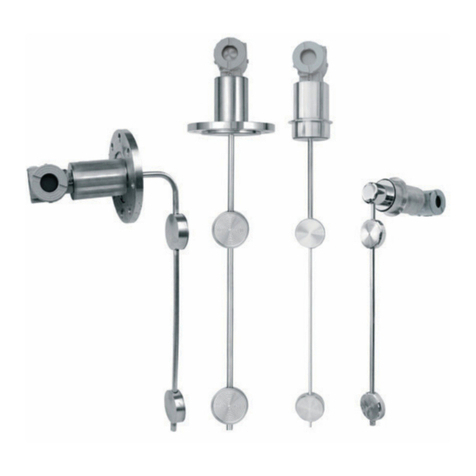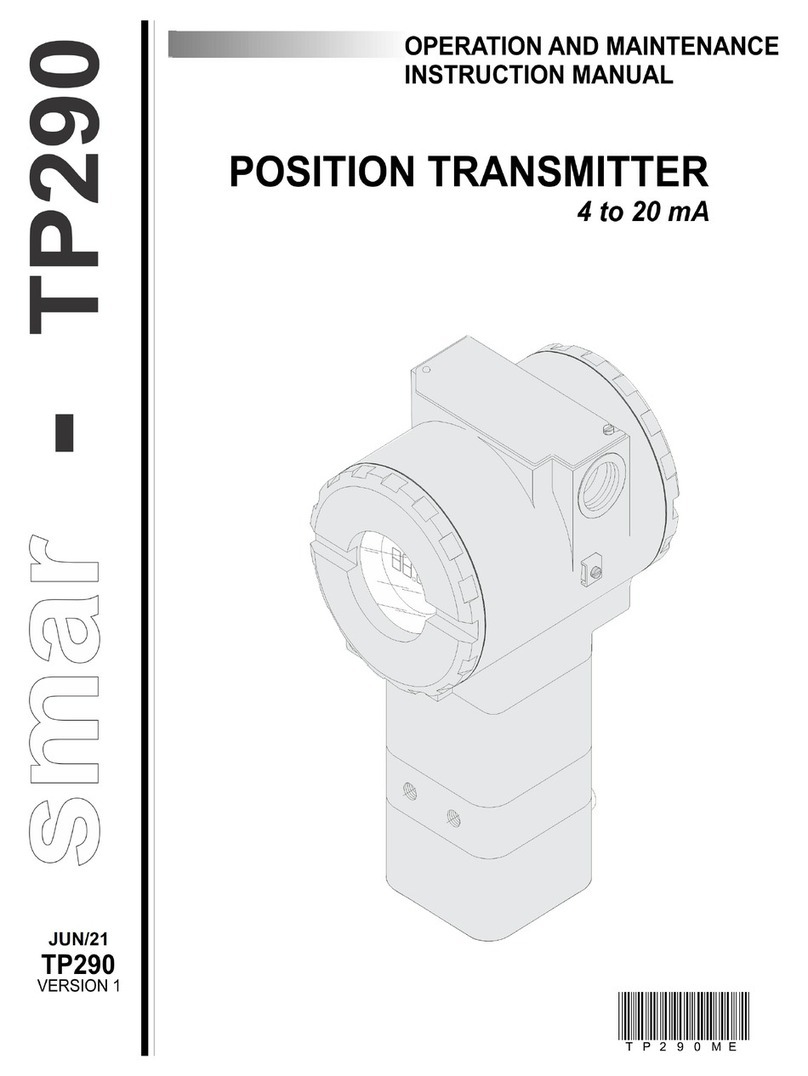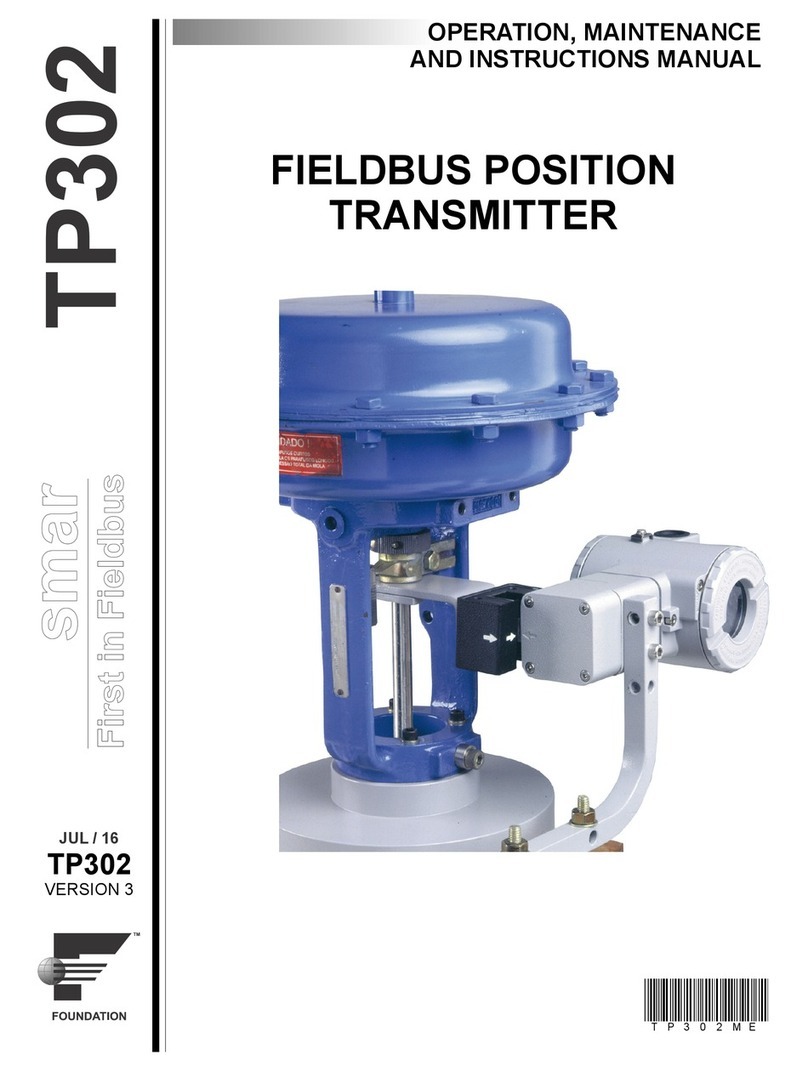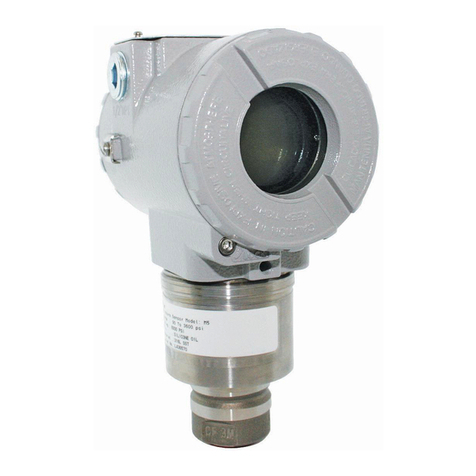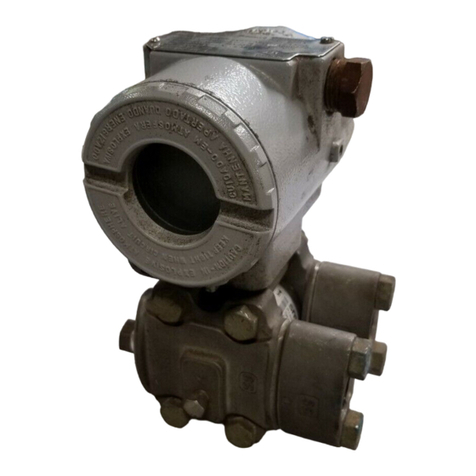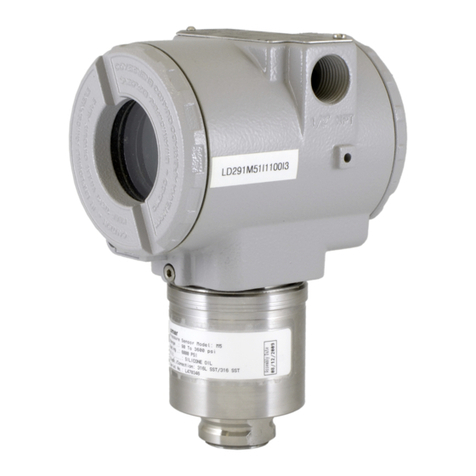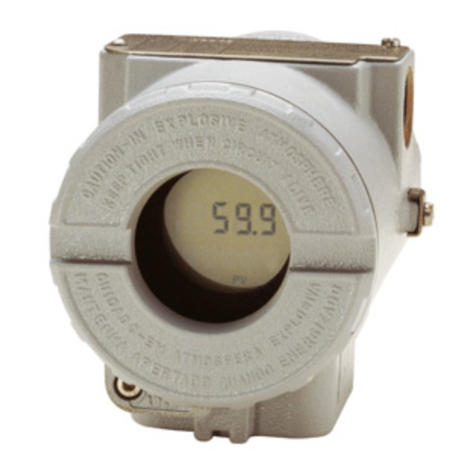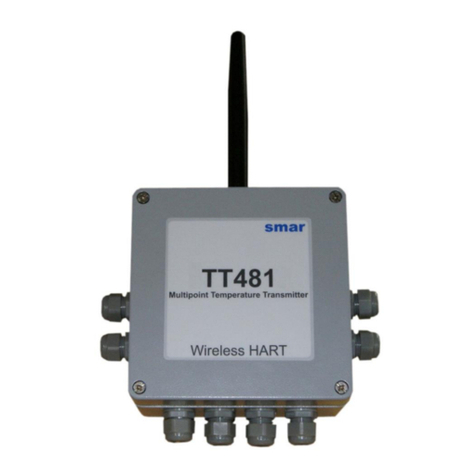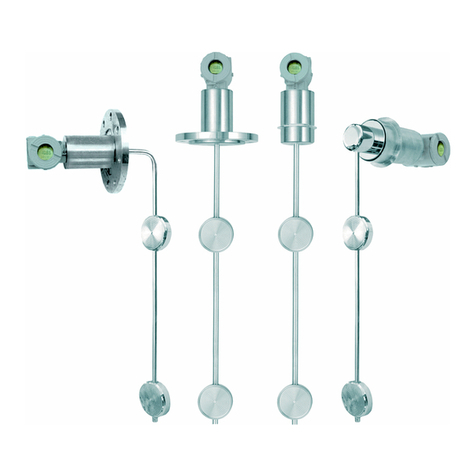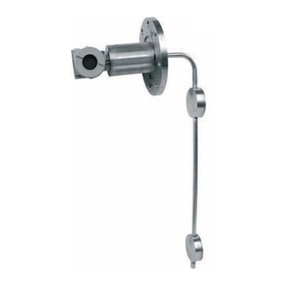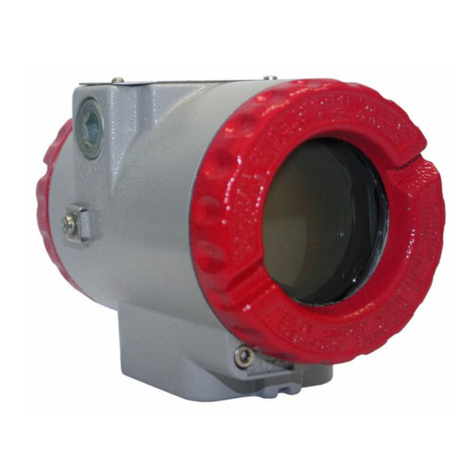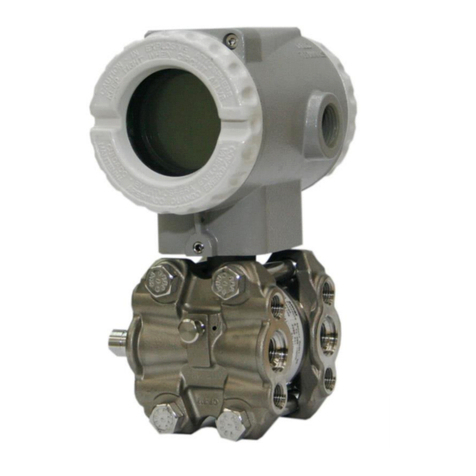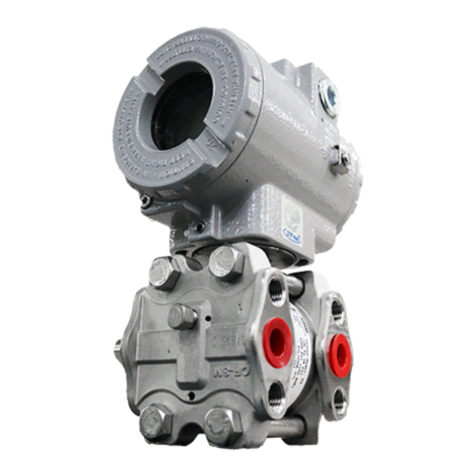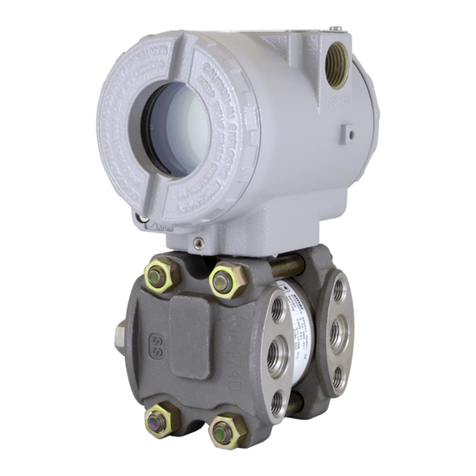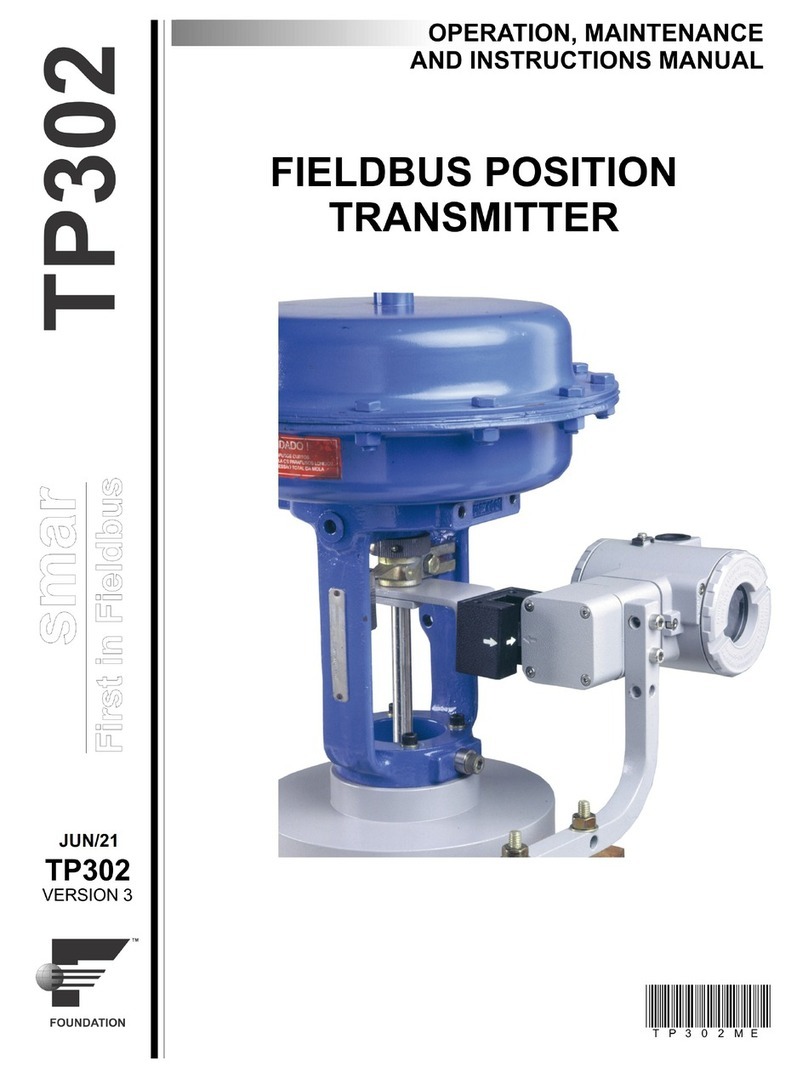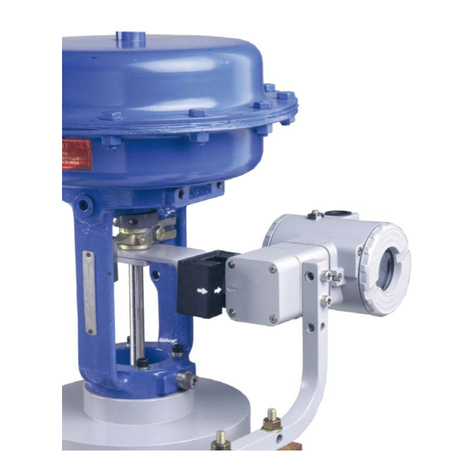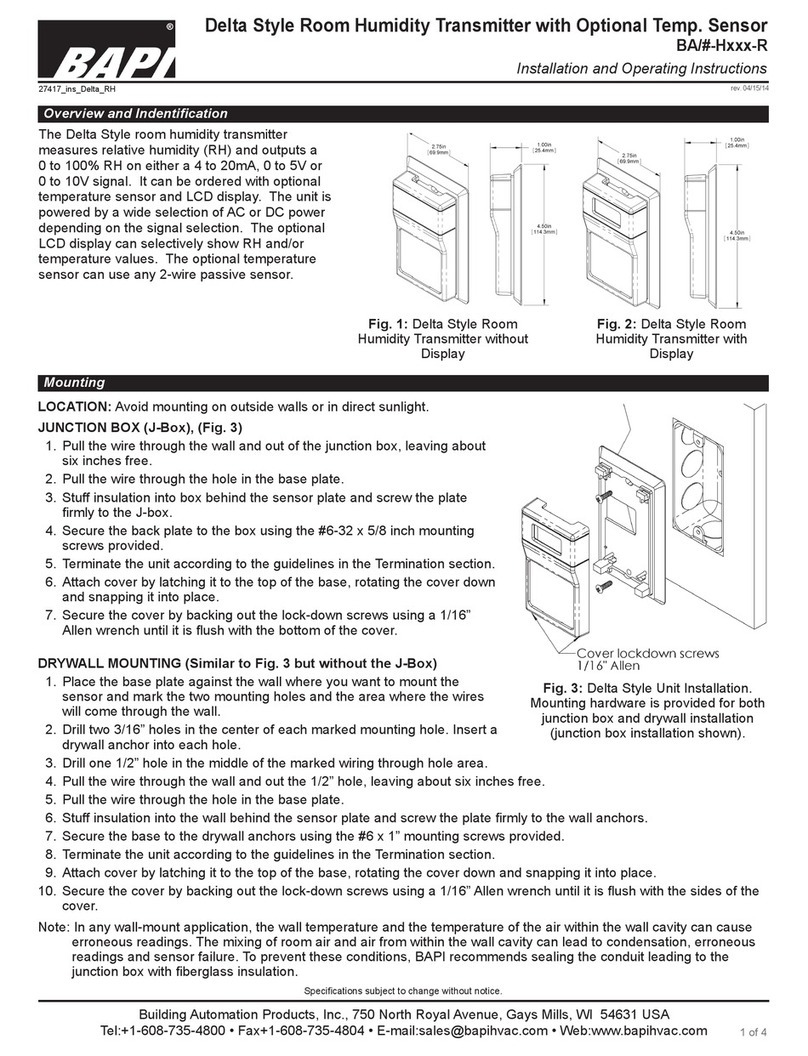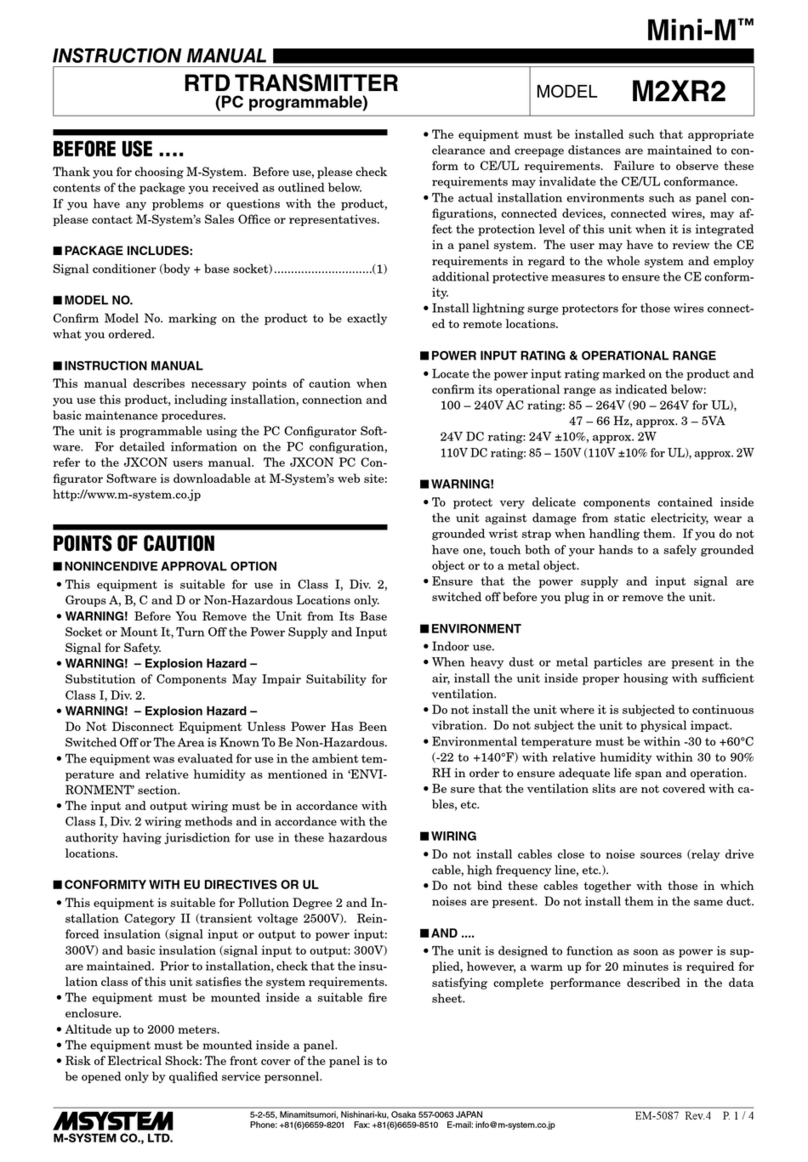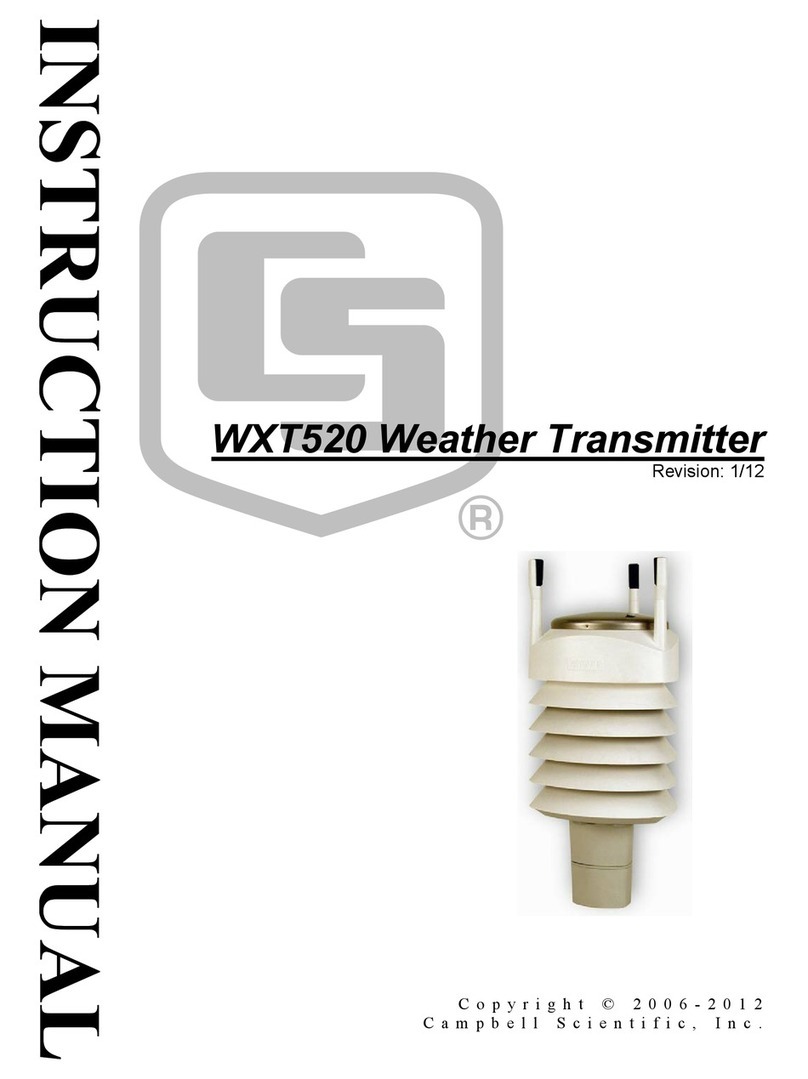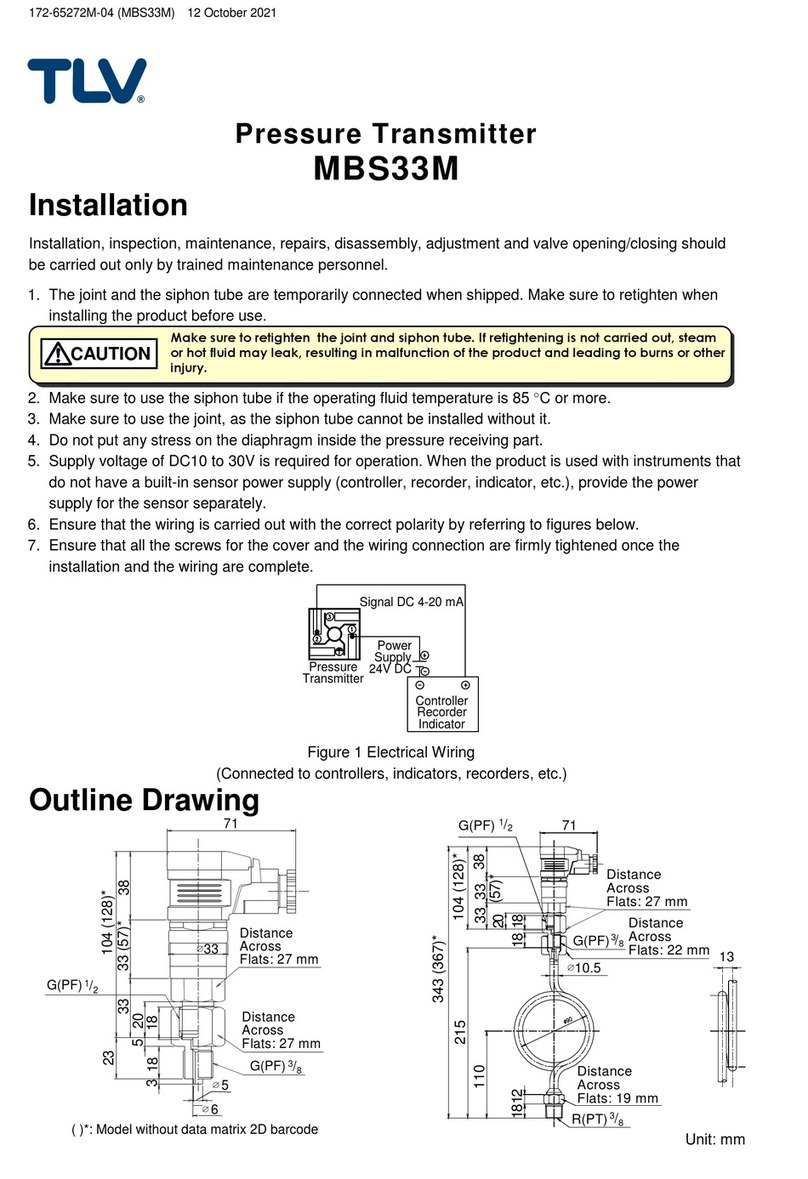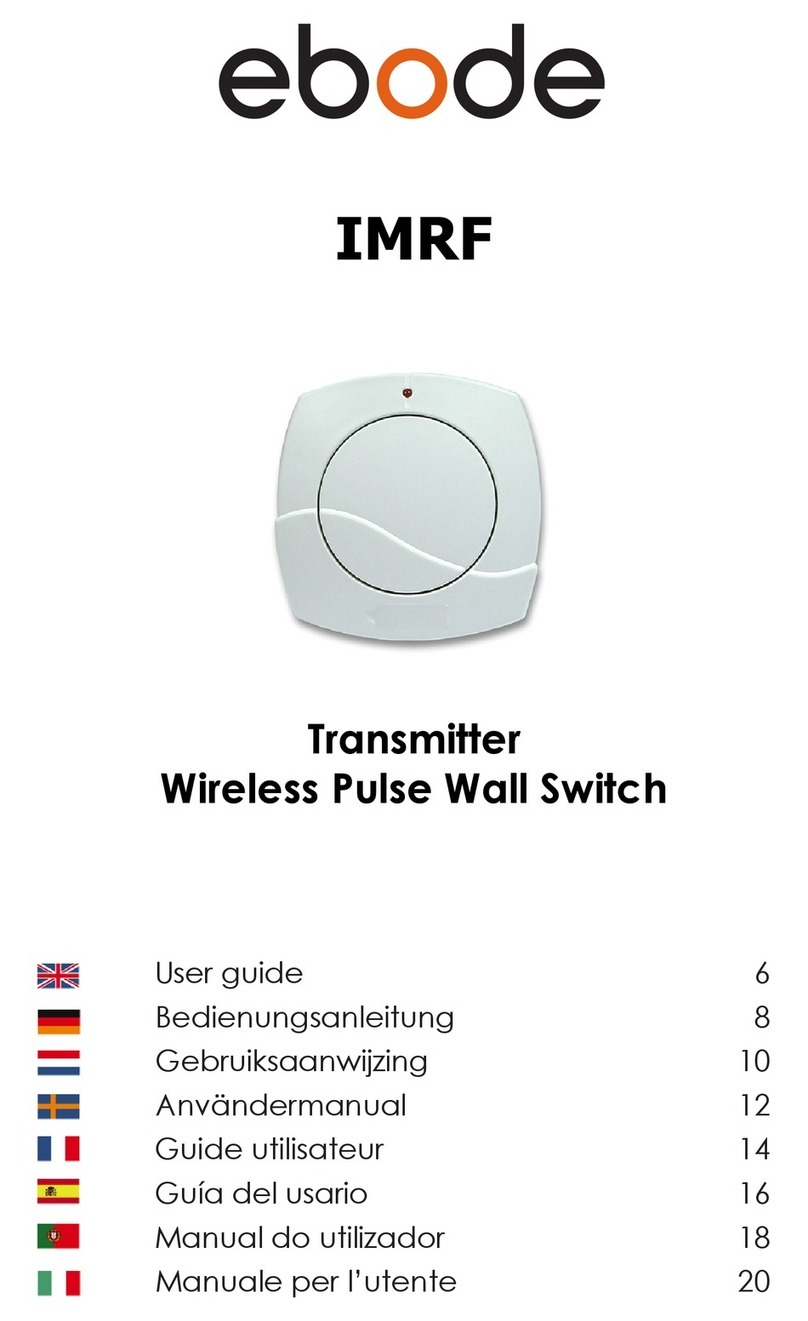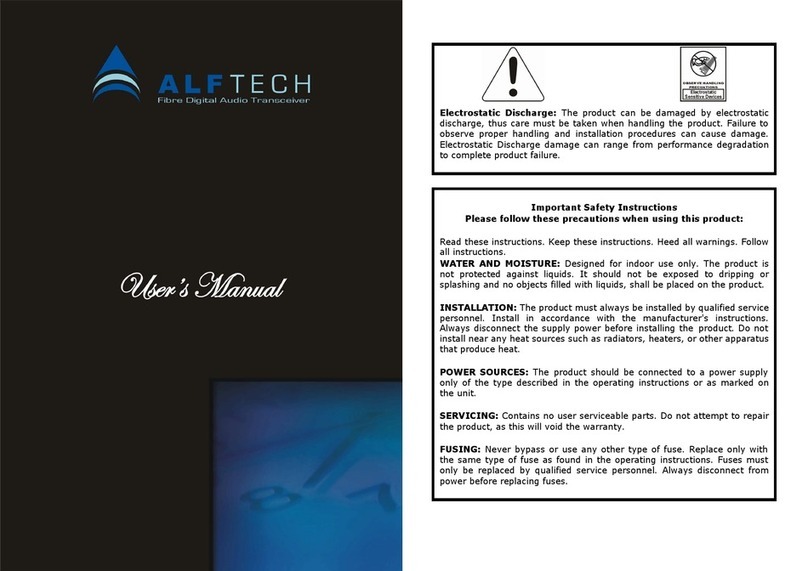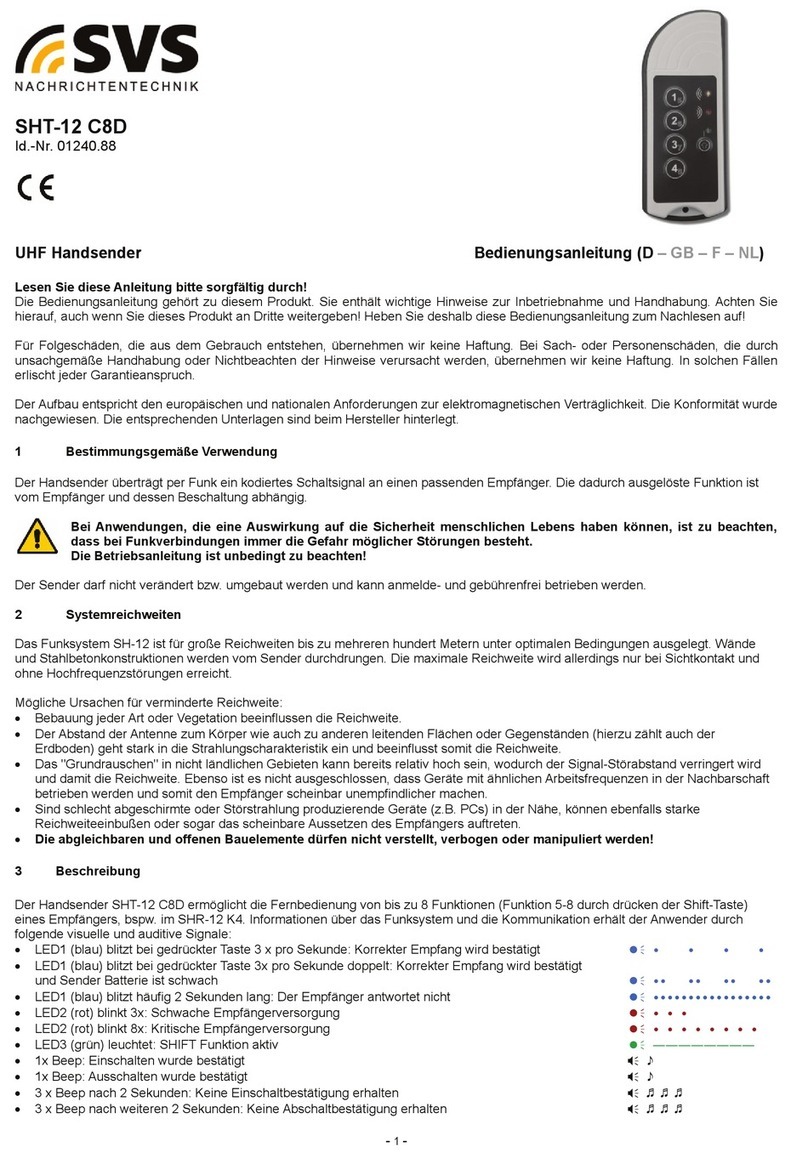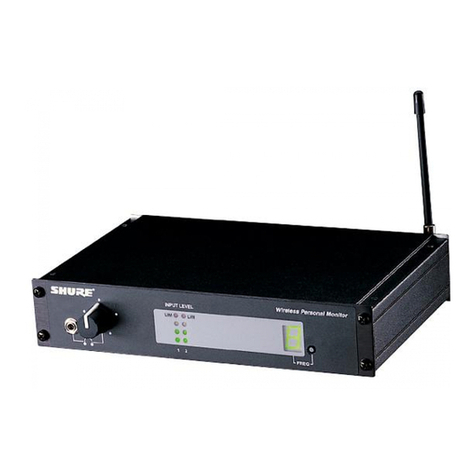SMAR TT301 Manual

TT301
Intelligent Temperature Transmitter
with Control Capability Optional
OPERATION & MAINTENANCE
INSTRUCTIONS MANUAL
T T 3 0 1 M E

www.el-scada.ru

Introduction
III
INTRODUCTION
The TT301 is a transmitter mainly intended for measurement of temperature using RTDs or
thermocouples, but can also accept other sensors with resistance or mV output such as:
pyrometers, load cells, resistance position indicators, etc. The digital technology used in the TT301
enables the choice of several output functions, an easy interface between the field and the control
room and several interesting features that reduce considerably the installation, operation and
maintenance costs.
The TT301, besides the normal functions offered by other smart transmitters, offers the following
functions:
SPECIAL SENSOR: the output follows a mV or Ohm input according to a 16-point linearization
table.
PID OUTPUT CHARACTERIZATION: the PID output signal (MV) follows a curve determined by 16
points.
BACKUP SENSOR: the process measurement is realized by two sensors, but only one supplies the
temperature. If it failure the other take its place.
INPUT SELECTOR: the selection between two sensor to obtain the measure is configured by user
based in the conditions of maximum, minimum or average temperature of the sensor.
CONTROLLER: the process variable is compared to a setpoint. The deviation acts on the output
signal according to a PID algorithm (Optional).
BATCH : setpoint generator allowing pre-programmed recipes of up to 2-week duration in 16 points.
LOCAL ADJUST: allow to set lower and upper value, sensor type, operation mode, indication,
setpoint, PID parameters without a configurator.
PASSWORD : three configurable levels for different functions.
CHANGE COUNTER: indicates the number of changes in each functions.
SPECIAL- SENSOR-UNIT: allows the reading to be indicated by one of 100 standard engineering
units or any special unit with up to 5 characters.
Get the best results of the TT301 by carefully reading these instructions.

TT301 –Operation & Maintenance Instruction Manual
IV
NOTE:
This Manual is compatible with version 4.XX, where 4 de notes software Version and XX software
"RELEASE". The indication 4.XXmeans that this manual is compatible with any release of software version
4.
Waiver of responsibility
The contents of this manual abides by the hardware and software used on the current equipment
version. Eventually there may occur divergencies between this manual and the equipment. The
information from this document are periodically reviewed and the necessary or identified corrections
will be included in the following editions. Suggestions for their improvement are welcome.
Warning
For more objectivity and clarity, this manual does not contain all the detailed information on the
product and, in addition, it does not cover every possible mounting, operation or maintenance
cases.
Before installing and utilizing the equipment, check if the model of the acquired equipment complies
with the technical requirements for the application. This checking is the user’s responsibility.
If the user needs more information, or on the event of specific problems not specified or treated in
this manual, the information should be sought from Smar. Furthermore, the user recognizes that the
contents of this manual by no means modify past or present agreements, confirmation or judicial
relationship, in whole or in part.
All of Smar’s obligation result from the purchasing agreement signed between the parties, which
includes the complete and sole valid warranty term. Contractual clauses related to the warranty are
not limited nor extended by virtue of the technical information contained in this manual.
Only qualified personnel are allowed to participate in the activities of mounting, electrical connection,
startup and maintenance of the equipment. Qualified personnel are understood to be the persons
familiar with the mounting, electrical connection, startup and operation of the equipment or other
similar apparatus that are technically fit for their work. Smar provides specific training to instruct and
qualify such professionals. However, each country must comply with the local safety procedures,
legal provisions and regulations for the mounting and operation of electrical installations, as well as
with the laws and regulations on classified areas, such as intrinsic safety, explosion proof, increased
safety and instrumented safety systems, among others.
The user is responsible for the incorrect or inadequate handling of equipments run with pneumatic
or hydraulic pressure or, still, subject to corrosive, aggressive or combustible products, since their
utilization may cause severe bodily harm and/or material damages.
The field equipment referred to in this manual, when acquired for classified or hazardous areas, has
its certification void when having its parts replaced or interchanged without functional and approval
tests by Smar or any of Smar authorized dealers, which are the competent companies for certifying
that the equipment in its entirety meets the applicable standards and regulations. The same is true
when converting the equipment of a communication protocol to another. In this case, it is necessary
sending the equipment to Smar or any of its authorized dealer. Moreover, the certificates are
different and the user is responsible for their correct use.
Always respect the instructions provided in the Manual. Smar is not responsible for any losses
and/or damages resulting from the inadequate use of its equipments. It is the user’s responsibility to
know and apply the safety practices in his country.

Table of Contents
V
TABLE OF CONTENTS
SECTION 1 - INSTALLATION ......................................................................................................................................1.1
GENERAL.....................................................................................................................................................................................1.1
MOUNTING...................................................................................................................................................................................1.1
ELECTRONIC HOUSING .............................................................................................................................................................1.2
WIRING.........................................................................................................................................................................................1.2
LOOP CONNECTIONS.................................................................................................................................................................1.3
INSTALLATION IN HAZARDOUS AREAS....................................................................................................................................1.7
EXPLOSION/FLAME PROOF.......................................................................................................................................................1.7
INTRINSICALLY SAFE.................................................................................................................................................................1.7
SECTION 2 - OPERATION ...........................................................................................................................................2.1
FUNCTIONAL DESCRIPTION-HARDWARE................................................................................................................................2.1
FUNCTIONAL DESCRIPTION - SOFTWARE ..............................................................................................................................2.4
TEMPERATURE SENSORS.........................................................................................................................................................2.5
THE DISPLAY...............................................................................................................................................................................2.7
MONITORING...............................................................................................................................................................................2.7
ALARM..........................................................................................................................................................................................2.8
SECTION 3 - CONFIGURATION ..................................................................................................................................3.1
CONFIGURATION RESOURCES ................................................................................................................................................3.3
PROGRAMMING TREE................................................................................................................................................................3.3
IDENTIFICATION AND MANUFACTURING DATA –INFO..........................................................................................................3.4
CONFIGURATOR - CONF............................................................................................................................................................3.4
CALIBRATION –RANGE..............................................................................................................................................................3.4
MAINTENANCE - MAINT..............................................................................................................................................................3.4
SENSOR TYPES - SENSOR........................................................................................................................................................3.5
CONECTION AND WORK MODEL ..............................................................................................................................................3.7
SPECIAL SENSOR CONFIGURATION........................................................................................................................................3.7
PID ………………………………………………………………………………………………………………………………………………3.8
MONITORING - MONIT................................................................................................................................................................3.9
CALIBRATING THE TT301.........................................................................................................................................................3.10
CALIBRATION WITHOUT REFERENCE....................................................................................................................................3.10
CALIBRATION WITH REFERENCE...........................................................................................................................................3.11
UNIT............................................................................................................................................................................................3.11
DAMPING ...................................................................................................................................................................................3.11
TRIM ...........................................................................................................................................................................................3.11
ALARM........................................................................................................................................................................................3.12
ALARM CONFIGURATION.........................................................................................................................................................3.12
ONLINE MULTIDROP OPERATION...........................................................................................................................................3.12
CONFIGURATION TT301 FOR MULTIDROP ............................................................................................................................3.13
MULTIDROP MODE CONFIGURATION ....................................................................................................................................3.13
SECTION 4 - PROGRAMMING USING LOCAL ADJUSTMENT.................................................................................4.1
THE MAGNETIC TOOL ................................................................................................................................................................4.1
RERANGING USING THE LOCAL ZERO AND SPAN ADJUSTMENTS IN SIMPLE MODE .......................................................4.2
COMPLETE LOCAL ADJUSTMENT.............................................................................................................................................4.3
OPERATION [OPER]....................................................................................................................................................................4.4
BATCH [BATCH]...........................................................................................................................................................................4.5
TUNING [TUNE]............................................................................................................................................................................4.6
CONFIGURATION [CONF]...........................................................................................................................................................4.9
SECTION 5 - MAINTENANCE PROCEDURES ...........................................................................................................5.1
GENERAL.....................................................................................................................................................................................5.1
DIAGNOSIS WITH SMAR CONFIGURATOR...............................................................................................................................5.1
ERROR MESSAGES....................................................................................................................................................................5.1
DIAGNOSTICS WITH THE CONFIGURATOR.............................................................................................................................5.1
TROUBLESHOOTING WITH TRANSMITTER..............................................................................................................................5.2
DISASSEMBLY PROCEDURE.....................................................................................................................................................5.3
REASSEMBLY PROCEDURE......................................................................................................................................................5.4
INTERCHANGEABILITY...............................................................................................................................................................5.4
RETURNING MATERIALS............................................................................................................................................................5.4

TT301 –Operation & Maintenance Instruction Manual
VI
SECTION 6 - TECHNICAL CHARACTERISTIC...........................................................................................................6.1
ORDERING CODE .......................................................................................................................................................................6.5
APPENDIX A - CERTIFICATIONS INFORMATION.................................................................................................... A.1
EUROPEAN DIRECTIVE INFORMATION...................................................................................................................................A.1
OTHER CERTIFICATIONS..........................................................................................................................................................A.1
IP68 REPORT:...........................................................................................................................................................................................A.1
HAZARDOUS LOCATIONS CERTIFICATIONS..........................................................................................................................A.1
NORTH AMERICAN CERTIFICATIONS....................................................................................................................................................A.1
EUROPEAN CERTIFICATIONS.................................................................................................................................................................A.2
SOUTH AMERICA CERTIFICATION .........................................................................................................................................................A.2
IDENTIFICATION PLATE AND CONTROL DRAWING...............................................................................................................A.2
IDENTIFICATION PLATE ..........................................................................................................................................................................A.2
CONTROL DRAWING...............................................................................................................................................................................A.5
APPENDIX B –SRF –SERCIVE REQUEST FORM................................................................................................... B.1

Installation Flowchart
VII
Installation Flowchart
Yes
Was the transmitter
configured on the bench
to match the application?
Configure the action and
the limit (Seção 3).alarm
Simule the value(s)
of the work range in the sensor(s)
conection terminal(s)
mV or Ohm
Start
No
No
OK
Yes
No
Yes
No
Yes
Configure the transmitter 1
and 3 - Configuration)
(Section
Section
Configure the measuring range
to 0% (4mA) and 100% (20mA)
(Section 3 - Configuration)
Configure the Damping
(Section 3 - Configuration)
Configure the LCD reading
(Section 3 - Configuration)
See manual
(Section 5 - )Maintenance
Is the reading correct?
Check the area classification
and its practices.
Install the transmitter preferably
on weather- protected areas.
Install the transmitter
(mechanically and electrically)
according to the application after
checking the best position for
the LCD (Section 5 - Maintenance)
Power the transmitter properly.
Is the transmitter
reading correct?
Do Zero and Span Trim
Did you correct the
transmitter reading?

TT301 –Operation & Maintenance Instruction Manual
VIII

Section 1
1.1
INSTALLATION
General
The overall accuracy of temperature and other measurements depends on severalvariables.Although
the transmitter has an outstanding performance, proper installation is essential,in orderto maximizeits
performance.
Among all factors, which may affect transmitter accuracy, environmental conditions are the most
difficult to control. There are, however, ways of reducing the effects of temperature, humidity and
vibration.
Mounting
Temperature fluctuation effects can be minimized bylocatingthe transmitterin areas protected from ex-
treme environmental changes.
In warm environments, the transmitter should be installed to avoid, as much as possible, direct expo-
sure to the sun. Installation close to lines and vessels subjected to high temperatures should also be
avoided. For temperature measurements, sensors with cooling-neck can be used or the sensor can be
mounted separated from the transmitter housing.
Use of sunshades or heat shields to protect the transmitter from external heat sources should be
considered, if necessary.
The transmitter may be mounted in two basic ways, as follows:
Separated from the sensor, using optional mounting brackets;
Mounted on the sensor assembly.
Using the brackets, the mounting may be done in several positions, as shown on Figure 1.1.
Measurement error can be decreased by using proper wires (see Section II, Operation).
ALLOW 150 MM MINIMUM FOR LOCAL
ZERO AND SPAN ADJUSTMENT WITH
MAGNETIC TOOL.
COMMUNICATIONS
TERMINAL
PLUG
CONDUIT
CONNECTION
MOUNTING BRACKET
PIPE 2"
PLUG
WALL OR
PANEL MOUNTING
FOR WALL MOUNTING
2 EXPANSION ANCHOR -
2 HEXAGON SCREW - S8
3/16”X70
2 BOLT AND NUTS - 1/4”X30
NOT INCLUDED
FOR PANEL MOUNTING
Figure 1.1 - Dimensional Drawing and Mounting Positions

TT301 –Operation & Maintenance Instruction Manual
1.2
WARNING
Do not remove the graphite grease from the covers, or they may jam.
Electronic Housing
Humidity is fatal to electronic circuits. In areas subjected to high relative humidity, the O-rings for the
electronics cover must be correctly placed. Removal of the electronics cover in the field should be
reduced to the minimum necessary, since each time it is removed; the circuits are exposed to the
humidity.
The electronic circuit is protected by a humidity proof coating, but frequent exposures to humidity may
affect the protection provided. It is also important to keep the covers tightened in place. Everytimethey
are removed, the threads are exposed to corrosion, since painting cannot protect these parts. Sealing
methods should be employed on conduit entering the transmitter.
One of the conduit inlets for electrical connection is used to mount the sensor integral to the
temperature transmitter (see Fig. 1.1).
WARNING
The unused cable entries should be plugged and sealed accordingly to avoid humidity entering,
which can cause the loss of the product’s warranty.
For better visibility, the digital indicator may be rotated in steps of 90o(see Section 5, Maintenance).
Reach the display and main board by removing the Cover with window. This cover should be locked
closed by the cover locking screw. To release the cover, rotate the locking screw clockwise. Seefigure
1.2.
COVER
LOCKING
SCREW
(a)
(b)
Figure 1.2- Cover Locking and Housing Rotating Set Screw (a) Electronic Board Side
(b) Terminal Connection Side
Wiring
Access the wiring block by removing the Electrical Connection Cover. This cover can be locked closed
by the cover locking screw (Figure 1.2- b). To release the cover, rotate the locking screw clockwise.
The terminals in the superior part marked with () and (−) are to receive the powering from 12 to 45
Vdc. The inferior terminals marked with the numbers from 1 to 4 they are for the connections of the
different types of sensor.
Test and Communication terminals allow, respectively, to measure the current in the 4 - 20 mA loop,
without opening it, and to communicate with the transmitter. To measure it, connect a multimeterin the
mA scale in the "" and "" TEST terminals. To communicate with it, use a HART configurator
between "" and "" COMM terminals. The wiring block has screws on which terminals type fork or
ring can be fastened, see Figure. 1.3.

Installation
1.3
GROUND
TERMINAL GROUND
TERMINALS
COMMUNICATION
TERMINALS TEST
TERMINALS
+
+ +
1 2 3 4
C
O
M
M
T
E
S
T
Figure 1.3 - Ground Terminal
The TT301 is protected against reversed polarity.
For convenience there are three ground terminals: one inside the cover and two external,located close
to the conduit entries.
Use of twisted pair (22 AWG) cables is recommended.
Avoid routing signal wiring close to power cables or switching equipment.
The Figure 1.3 shows the correct installation of the conduit, in order to avoid penetration of water, or
other substance, which may cause malfunctioning of the equipment.
CORRECT
WIRES INCORRECT
Figure 1.4 - Conduit Installation Diagram.
Loop Connections
WARNING
Do not connect the Power Supply to the sensor terminals (Terminals 1, 2, 3 and 4).
Connection of the TT301 working as transmitter should be performed as in Figure 1.6.
CONFIGURATOR
250
Figure 1.5 –Wiring Diagram for the TT301 Working as Transmitter
Connection of the TT301 working as a controller (Optional) should be as indicated in Figure 1.5.

TT301 –Operation & Maintenance Instruction Manual
1.4
CONFIGURATOR
POWER
SUPPLY
250
Figure 1.6 –Wiring Diagram for the TT301 Working as Controller
Connection of the TT301 in multidrop configuration should be done as in Figure 1.6. Note that a
maximum of 15 transmitters can be connected on the same line and that they should be connected in
parallel. When many transmitters are connected to the same line, calculate the voltage drop through
the 250 Ohm resistor and verify that the voltage of the power supply is enough (Figure 1.7).
Wiring diagram for the TT301 in multidrop.
WARNING
For proper operation, the configurator requires a minimum load of 250 Ohm between it and the
power supply.
TT301
# 2
TRANSMITTER TT301
# 3
TRANSMITTER TT301
# 15
TRANSMITTER
POWER
SUPPLY
250
CONFIGURATOR
TT301
TRANSMITTER
# 1
Figure 1.7 - Wiring Diagram for the TT301 in Multidrop Configuration
The Configurator can be connected to the communication terminals of the transmitter or at anypoint of
the signal line by using the interface with alligator clips.
It is also recommended to ground the shield of shielded cables at only one end. The not grounded end
must be carefully isolated.
NOTE
Make sure that the transmitter is operating within the operating area as shown on the load diagram
(Figure 1.9). Communication requires a minimum load of 250 Ohm.

Installation
1.5
1650
1500
1000
500
012 20 30 40 45
250
Power Supply [ Volt ]
4-20mA only
Operating area
4-20mA and digital
communication
17
Figure 1.8 –Load Curve
The sensor should be connected as per Figure 1.8.
WARNING
When operating with two sensors, the sensors can not be both grounded.At leastone has tobe not
grounded for proper operation of TT301.

TT301 –Operation & Maintenance Instruction Manual
1.6
2 - WIRE RTD
OR OHM INPUT 3 - WIRE RTD
OR OHM INPUT 4 - WIRE RTD
OR OHM INPUT
THERMOCOUPLE OR
MILIVOLT INPUT DIFFERENTIAL RTD
OR OHM INPUT
BACKUP, MINIMUM,
MAXIMUM OR AVERAGE
WITH 2 TC OR MILIVOLT
BACKUP, MINIMUM,
MAXIMUM OR AVERAGE
WITH 2 RTD OR OHM
12
12
1 2 341 2 34
1 2 34
1 2 34 1 2 341 2 34
1 2 34
+-DIFFERENTIAL THERMOCOUPLE
OR MILIVOLT INPUT
1 2 34
+-
+ +
- -
Figure 1.9 –Sensor Wiring

Installation
1.7
Installation in Hazardous Areas
WARNING
Explosions could result in death or serious injury, besides financial damage. Installation of this
transmitter in explosive areas must be carried out in accordance with the local standards and the
protection type adopted .Before continuing the installation make sure thecertificateparametersareI n
accordance with the classified area where the equipment will be installed.
The instrument modification or parts replacement supplied by other than authorized representative of
Smar is prohibited and will void the certification.
The transmitters are marked with options of the protection type. The certification is validonlywhen the
protection type is indicated by the user. Once a particular type of protection is selected, any othertype
of protection can not be used.
Explosion/Flame Proof
WARNING
Only use Explosion Proof/Flameproof certified Plugs, Adapters and Cable glands.
In Explosion-Proof installations the cable entries mustbe connected orclosed using metal cable gland
and metal blanking plug, both with at least IP66 and Ex-d certification.
The standard plugs provided by Smar are certified according to CEPEL certificate. If theplugneedsto
be replaced, a certified plug must be used.
The electrical connection with NPT thread must use waterproofing sealant. A non-hardening silicone
sealant is recommended.
For NEMKO ATEX certificate please to follow the installation guidelines inhazardouslocations below:
Group II Category 2G, Ex d, Group IIC, Temperature Class T6, EPL Gb U = 28VDC
Ambient Temperature: -20 to 60ºC for T6
Environmental Protection: IP66/687 or IP66W/687W
The electrical connection available are ½ - 14NPT and M20x1,5.
Cable entries must be connected or closed using metal cable gland andmetal blankingplug,bothwith
at least IP66 and Ex-d certification or any appropriate ATEX approved metal cable gland and metal
blanking plug. Do not remove the transmitter covers when power is ON.
Intrinsically Safe
WARNING
In hazardous zones with intrinsically safe or non-incendive requirements, the circuitentityparameters
and applicable installation procedures must be observed.
To protect the application the transmitter must be connected to a barrier. Match the parameters
between barrier and the equipment (Consider the cable parameters). Associated apparatus ground
bus shall be insulated from panels and mounting enclosures. Shield is optional. If used, be sure to
insulate the end not grounded. Cable capacitance and inductance plus CiandLimustbesmallerthan
Co and Lo of the associated Apparatus.
For free access to the Hart bus in the explosive environment, ensure the instruments in the loop are
installed in accordance with intrinsically safe or non-incendive field wiring practices. Use onlyExHart
communicator approved according to the type of protection Ex-i (IS) or Ex-n (NI).
It is not recommended to remove the transmitter cover when the power is ON.

TT301 –Operation & Maintenance Instruction Manual
1.8

Section 2
2.1
OPERATION
The TT301 accepts signals from mV generators such as thermocouples or resistive sensors such as
RTDs. The criterion is that the signal is within the range of the input. For mV, the range is -50 to 500
mV and for resistance, 0 to 2000 Ohm.
Functional Description-Hardware
Refer to the block diagram (Figure 2.1). The function of each block is described below.
LOCALADJUST
MODEM
BELL 202
POWER
SUPPLY
OUTPUT
DISPLAY
CONTROLLER
AMBIENT
TEMPERATURE
SENSOR DISPLAY BOARD
SUPPLY
SUPPLY
MAIN BOARDINPUT BOARD
MUX SIGNAL
CONDI-
TIONER
TC
Ohm
RTD
mV
I
S
O
L
A
T
O
R
A/D
CONVER-
TER
D/A
CONVERTER
PROCESSING UNIT
RANGES
SPECIAL FUNCTIONS
PID (OPTIONAL)
OUTPUT CONTROL
SERIAL COMMUNICATION
HART PROTOCOL
POWER
ISOLATION
Figure 2.1 –TT301 Block Diagram
MUX-Multiplexer
The MUX multiplexes the sensor terminals to the signal conditioning section ensuring that the voltages
are measured between the correct terminals.
Signal Conditioner
Its function is to apply the correct gain to the input signals to make them suit the A/D converter.
A/D Converter
The A/D converts the input signal to a digital format for the CPU.
Isolator
Its function is to isolate the control and data signal between the input and the CPU.
CPU - Central Processing Unit & PROM
The CPU is the intelligent portion of the transmitter, being responsible for the management and
operation of all other blocks: linearization, cold junction compensation and communication. The
program is stored in the PROM as well as the linearization data for the temperature sensors.
For temporary storage of data, the CPU has an internal RAM, the data in the RAM is lost if the power is
switched off, however the CPU also has an internal nonvolatile EEPROM where data that must be
retained is stored. Examples of such data are: calibration, configuration and identification data.
D/A Converter
Converts the digital data from the CPU to an analog signal with 14-bits resolution.
Output
Controls the current in the line feeding the transmitter. It acts as a variable resistive load whose value

TT301 –Operation and Maintenance Instruction Manual
2.2
depends on the voltage from the D/A converter.
Modem
Modulates a communication signal on the current line. A "1" is represented by 1200 Hz and a "0", by
2200 Hz. These signals are symmetric and do not affect the DC level of the 4-20 mA signal.
Power Supply
Power shall be supplied to the transmitter circuit using the signal line (2-wire system). The transmitter
quiescent consumption is 3.6 mA; during the operation, consumption may be as high as 21 mA,
depending on the measurement and sensor status.
The TT301, in the transmitter mode, shows failure indication at 3.6 mA if configured for low signal
failure; at 21 mA, if configured for high signal failure; 3.8 mA in the case of low saturation; 20.5 mA in
the case of high saturation and measurements proportional to the applied temperature in the range
between 3.8 mA and 20,5 mA. 4 mA corresponds to 0% of the working range and 20 mA to100 % of
the working range.
Power Isolation
Its function is to isolate power supply between the input and the CPU.
Display Controller
Receives data from the CPU informing which segments of the Liquid Crystal Display, should be turned
on.
Local Adjustment
Two switches that are magnetically activated. They can be activated by the magnetic tool without
mechanical or electrical contact.

Operation
2.3
C TEMP.
SENSOR
DIGITAL FILTER
INPUT
TRIM
RANGING
SPECIAL
SENSOR
PID
AUTO/MANUAL
ACTION
KP, TR, TD
A/M
MV
POWER-ON
SAFETY-OUT
HIGH
LOW
OUT RATE
MV-FEEDBACK
LIMITS
( BUMPLESS A/M )
OUTPUT
4-20mA
CURRENT
TRIM DISPLAY
INDICATOR
SPAN
PAUSE
RESET
XMTR
CONST
4 mA
20 mA
1 2
OUT %
PRIMARYAND
SECONDARY
UNIT
DAMPING
SETPOINT
mA
SP
SP TRACKING
SP GENERAL
SP TABLE
PID BLOCK (OPTIONAL)
OP-MODE
PID
TIME
GENERATOR
ALARM
ACTION-0
ACTION-1
ACTION-2
LIMIT-1
LIMIT-2
SP ( ENG )
ERROR %
mA
PV%
OUT%
SP %
SP ( ENG )
PV ( ENG )
T. AMB.
ERROR %
TI
STANDARD SENSOR
LINEARIZATION
& CJ COMPENSATION
INPUT
ohm / mV
TI min
PV %
URV
LRV
BURNOUT
PV %
TYPE / CONNECTION
UNIT
TABLE
LRL / URL / MIN
TABLE
Figure 2.2 –Software Flow Chart

TT301 –Operation and Maintenance Instruction Manual
2.4
Functional Description - Software
Refer to the block diagram (Figure 2.2). The function of each block is described below.
Input
Calculates the actual mV or Ohm from the value sensed by the input circuitry.
Digital Filter
The digital filter is a low-pass filter with an adjustable time constant. It is used to smooth noisy signals.
The Damping value is the time required for the output to reach 63.2% for a step input of 100%.
Input Trim
Here, the value obtained by READING-TRIM is used to correct the transmitter for long term drift.
Standard Sensor Linearization & Compensation
Here, the mV and Ohm measurements are linearized and cold-junction compensated according to the
sensor characteristics stored in the CPU. The CPU contains data about most standard sensors
available.
Ranging
It is used to set the process values corresponding to the output 4 and 20 mA in transmitter mode or
process variable 0 and 100% in PID mode. In transmitter mode the LOWER-VALUE is the point
corresponding to 4 mA, and UPPER-VALUE is the point corresponding to 20 mA. In PID mode, the
LOWER-VALUE corresponds PV = 0% and UPPER-VALUE corresponds to PV = 100%.
Time Generator (Optional)
Counts the time to be used by the Setpoint generator function. It may be paused by using PAUSE or
set to any value inside the table.
Setpoint (Optional)
Here, the setpoint is adjusted in PID. In this block, Setpoint tracking may be activated in SP-TRACK.
The setpoint may also be generated automatically by turning the SP-GENERATOR on. When running,
the setpoint generator will ramp and dwell the setpoint according to a table (recipe) configured in SP-
TABLE.
PID (Optional)
First the error is calculated as SP-PV or PV-SP depending on which action (direct or reverse) is
configured in ACTION. When Calendar Van Dussen function is used, the SP table points number is
limited to 14 points instead to 16.
TABLE POINTS
This block relates the output (%) with the input (%) according to a 16 table points. The output is
calculated through the interpolation of these points.
Auto/Manual (Optional)
The Auto/Manual mode is toggled in PID. In Manual, MV may be adjusted by the user in the INDIC
option. The SP-POWER-ON option is used here to determine in which mode the controller should be
upon powering it on.
Limits (Optional)
This block makes sure that the MV does not go beyond its minimum and maximum limits as
established by the HIGH-LIMIT and LOW-LIMIT. It also makes sure that the Rate-of-Change does not
exceed the value set in RATE-CHNG.
Output
Calculates the current proportional to the process variable or manipulatedvariableto betransmitted on
the 4-20 mA output depending on the configuration in OP-MODE. This block also containsthe constant
current function configured in OUTPUT. The output is physically limited to 3.6 to 21 mA.
Current Trim
The 4 mA TRIM and 20 mA TRIM are used to make the transmitter current comply with a current
standard, should a deviation arise.
Display
Alternates two indications as configured in DISPLAY. The engineering unit fortheprocess variable can
).
1
(dt
dPV
Tdedt
Tr
eKpMV
Table of contents
Other SMAR Transmitter manuals
Popular Transmitter manuals by other brands
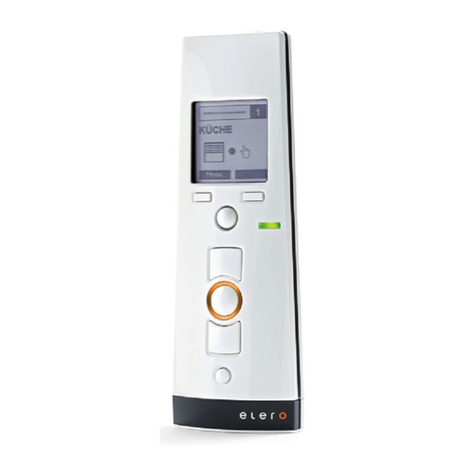
elero
elero TempoTel 2 operating instructions

Endress+Hauser
Endress+Hauser Cerabar M PMP51 owner's manual
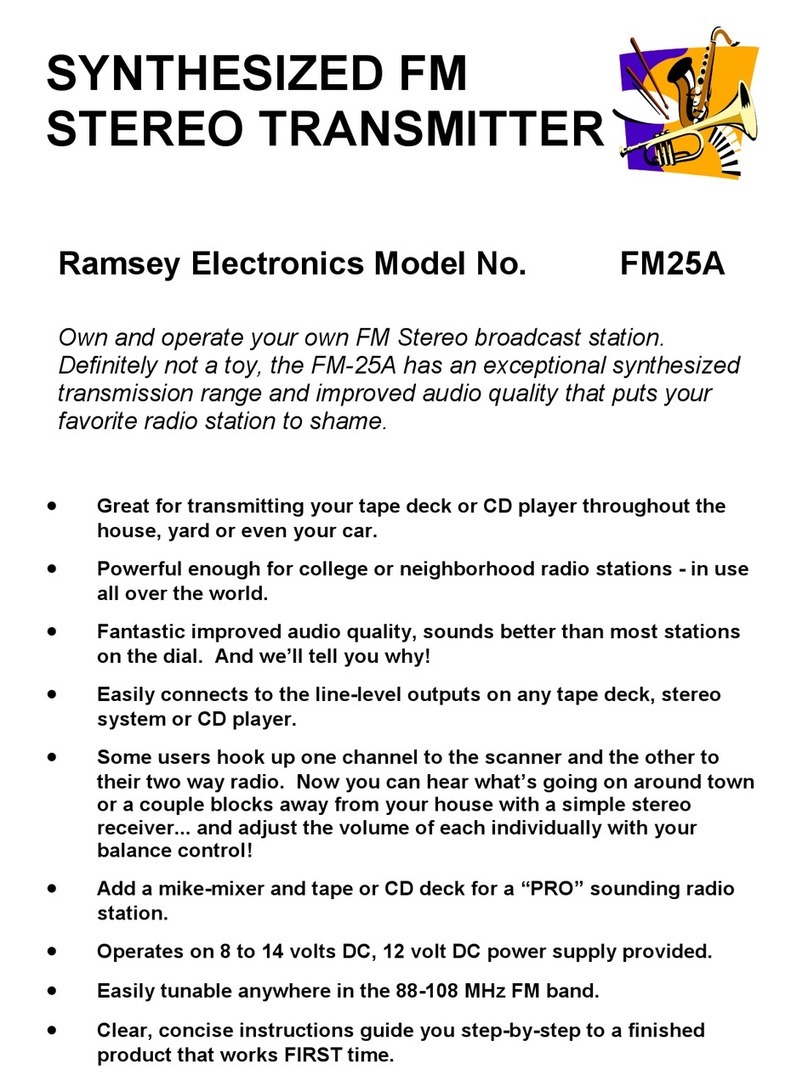
Ramsey Electronics
Ramsey Electronics FM25A Assembly and instruction manual

Eclipse
Eclipse 705 Installation and operating manual
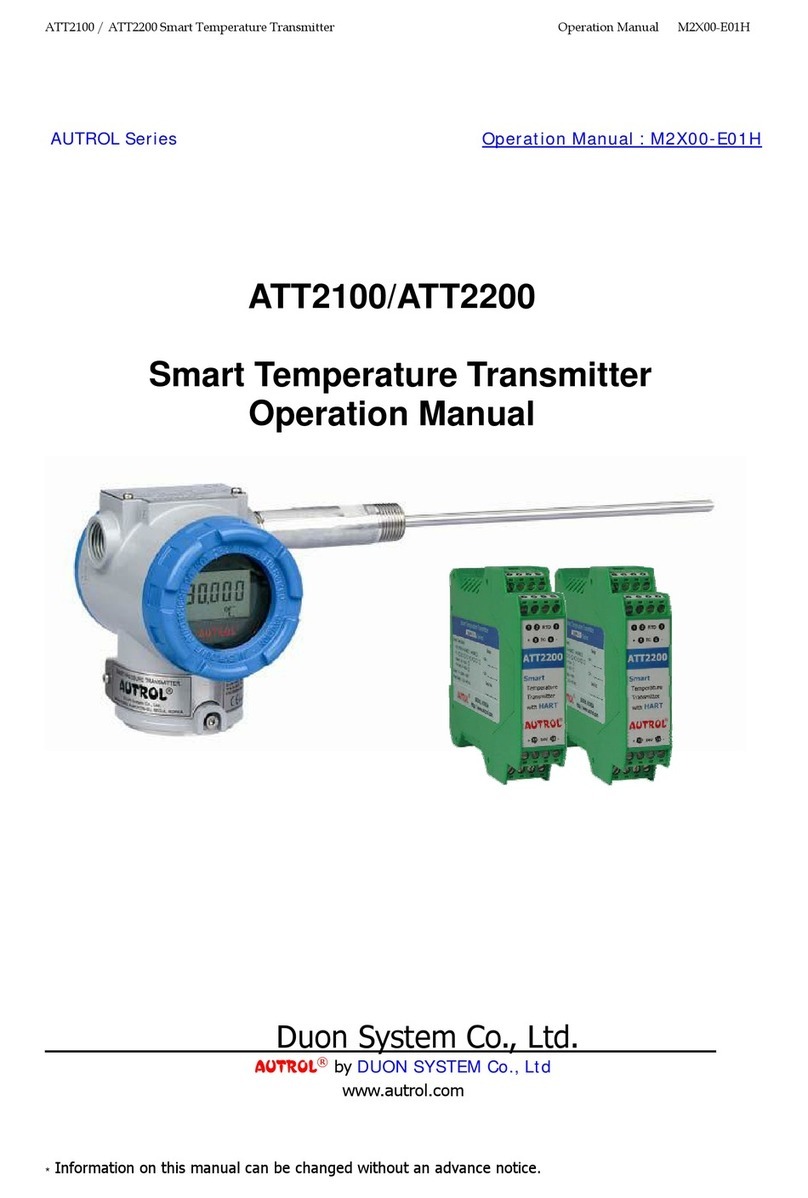
Duon System
Duon System AUTROL Series Operation manual
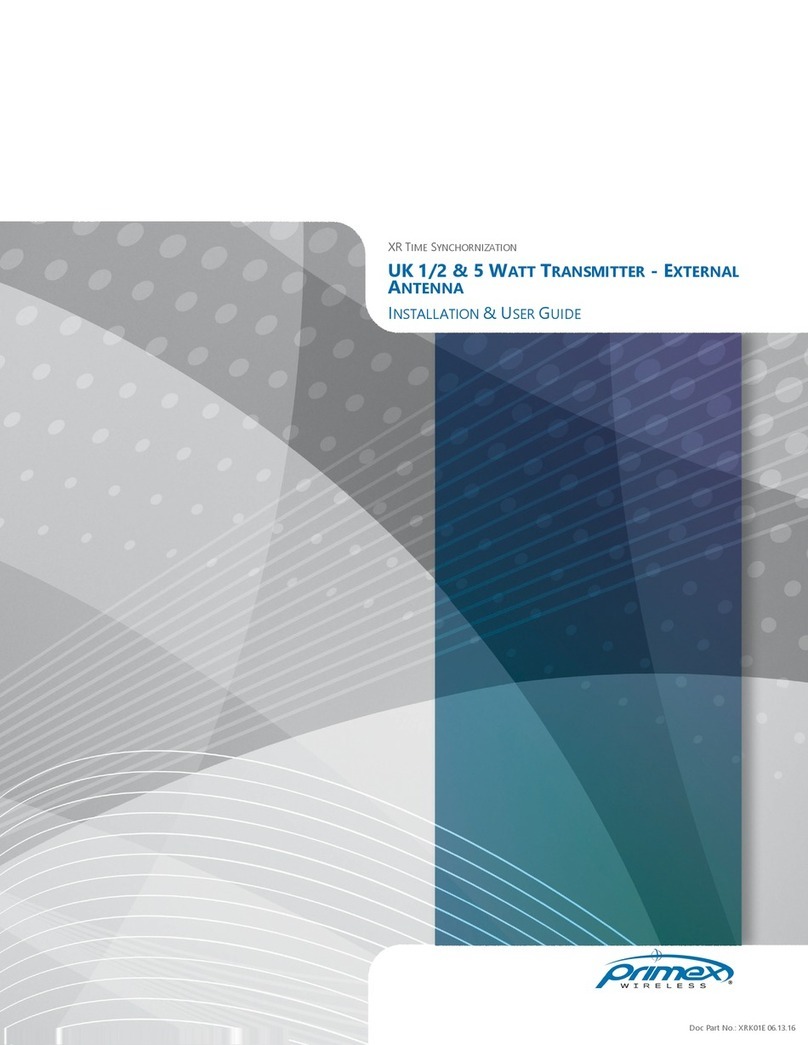
Primex
Primex XR TIME SYNCHRONIZATION Installation & user guide
